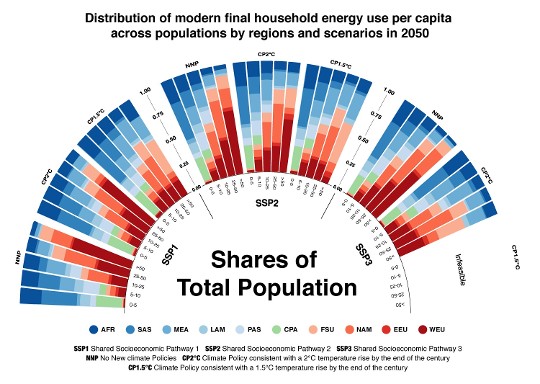
Access to modern, reliable, and affordable energy services is a must for development and ensuring a decent quality of life. IIASA researchers used a novel bottom-up approach to analyze how access to energy services may evolve over time under different scenarios of socioeconomic growth and policy scenarios that meet climate mitigation goals.
Energy access policies introduced around the world in the last decade have led to an encouraging decline in the number of people without access to electricity. Much of this progress is however now being hampered due to the COVID-19 pandemic and its associated socioeconomic impacts. Combined with the impacts of climate change and extreme weather events, the number of people left in the dark is set to increase, pushing back hopes of achieving universal access to modern energy services by 2030 as set out in the UN’s Sustainable Development Goal (SDG) 7.
While a lot of research has been done around access to modern energy services, most of these studies have focused on the technologies and investments needed to achieve access goals and specific benefits that can be gained. Less is however understood about how preferences for energy services shift and demands vary across diverse populations as modern forms of energy become more readily accessible and affordable over time.
The authors of a new study published in Nature Energy set out to address this knowledge gap by using a novel bottom-up approach to analyze how access to energy services in homes may evolve over time under different scenarios of socioeconomic growth and under policy scenarios that meet climate mitigation goals. In addition, the study highlights the inequalities in access to energy services for comfort and convenience across the globe, to help guide efforts to achieve the ambitions of SDG7 and reduce global inequalities (SDG 10).
“Unlike previous global studies that looked at these aspects in a highly aggregate manner, our study is built up from the household level. We simulated many diverse, individual households, which allowed for a very detailed analysis of inequalities. We wanted to determine how access to energy services across households differs under different scenarios, which energy services are prioritized by households, and how climate policy scenarios may affect those choices,” explains study lead author Miguel Poblete-Cazenave, a researcher in the IIASA Transformative Institutional and Social Solutions Research Group.
The researchers analyzed eight scenarios representing different combinations of socioeconomic and climate futures describing varying degrees of challenges in meeting adaptation and mitigation goals, from a world on a sustainable development path and that limits global warming to below 1.5 ºC (SSP1-CP1.5ºC), to a future with low-economic growth, high population growth, increasing inequality, and lower urbanization rates, where no new policies to prevent climate warming are put into effect (SSP3-NNP).
 © Adam Islaam | International Institute for Applied Systems Analysis (IIASA)
© Adam Islaam | International Institute for Applied Systems Analysis (IIASA)
(Sub-Saharn Africa (AFR), South Asia (SAS), Middle East and North Africa (MEA), Latin America and the Caribbean (LAM), Other Pacific Asia (PAS), Centrally Planned Asia and China (CPA), Former Soviet Union (FSU), North America (NAM), Central and Eastern Europe (EEU), and Western Europe (WEU))
Poblete-Cazenave notes that socioeconomically diverse households in different regions don’t behave in the same way. While in theory it can, for example, be expected that low-income households in hotter regions may be willing to allocate part of their budget to cooling their homes, their preferences indicate that entertainment is a greater priority. A reason for this could be that the cost of appliances for entertainment is lower than the cost of appliances for cooling, or the fact that households in these regions historically have a higher tolerance to higher temperatures. Convenience services such as appliances for cleaning and food preparation, on the other hand, are mostly acquired by households with higher levels of income.
Overall, the researchers say that achieving climate goals as well as universal access to modern electricity services for populations in regions that currently lack access are not at odds, despite indications that energy demand will likely continue to rise. In terms of inequalities, scenarios where ambitious climate targets are achieved do not significantly alter access to energy services in, for instance, the Global South, as households in this region suffer from heavier affordability constraints, regardless of the effects of climate policies. Financial subsidies, appliance rebates, and access to easy credit will be important to enable poor households in this region to afford access to key energy services related to thermal comfort, food preparation and conservation, and cleaning over the next decades.
In wealthier regions like North America and Western Europe that typically depend on gas heating, close to a fifth of the population may struggle to pay heating bills in 2050 under ambitious climate mitigation scenarios due to increasing prices of gas and oil-based fuels. For these countries, the researchers say, efforts to shield low-income households from price increases and improve the efficiency of heating services will be critical over the next few decades. The authors point out that even if such measures are put in place, inequalities in home energy use would likely persist, with the wealthiest 500 million people consuming about the same amount of energy as the poorest 5 billion put together by 2050.
“We hope that this paper will contribute to shifting the current supply focus in efforts to expand access to modern energy services universally and highlight the inequalities in access to energy services for comfort and convenience across the globe. Highlighting the importance of diverse socioeconomic characteristics of households and how these affect energy and appliance choices, is particularly relevant. This is really crucial for understanding the roots of inequality,” concludes study coauthor and Transformative Institutional and Social Solutions Research Group Leader, Shonali Pachauri.
Reference
Poblete-Cazenave, M., Pachauri, S., Byers, E., Mastrucci, A., van Ruijven, B. (2021). Global scenarios of household access to modern energy services under climate mitigation policy. Nature Energy DOI: 10.1038/s41560-021-00871-0
News

22 July 2024
Are sustainable aviation fuels truly sustainable?

17 July 2024
Forests endure as carbon sink despite regional pressures

16 July 2024


